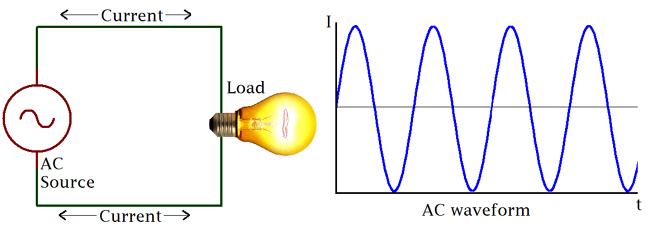What is Alternating Current
What is Alternating Current?
Alternating current (AC) is an electric current which periodically reverses direction and changes its magnitude continuously with time in contrast to direct current (DC) which flows only in one direction.
Alternating current is represented by a periodic function. The waveform of the current may sinusoidal, square, triangular or sawtooth type etc. The average value of an pure alternating current is zero. These are the waveforms of different alternating currents.

RMS Values of Alternating Current
The value of alternating current is generally represented with its RMS value.
The RMS value of sinusoidal alternating current is
![]() Where Im is the peak value
Where Im is the peak value
The RMS value of square alternating current is
= Im
Where Im is the peak value
The RMS value of triangular alternating current is
= Im / √3
Where Im is the peak value
The RMS value of sawtooth alternating current is
= Im / √3
Where Im is the peak value
AdBlock-2
Measurement of Alternating Current
Alternating current can be measured by using moving iron type ammeter. Although PMMC instrument can also be used to measure alternating current but in this case the alternating current first been rectified before it is measured by PMMC instrument
Advantage of Alternating Current or AC
Disadvantage of Alternating Current
Thea main disadvantage of alternating current is that it has skin effect and proximity effect, when it flows through a conductor. Because of skin effect, an alternating current always tries to flow through the outer surface of the conductor which increases the effective resistance of the conductor. To minimize skin effect, generally, conductors of alternating current are made stranded to increase the surface area of the conductor. Proximity effect is similar to skin effect and due to proximity effect, current distribution across the cross section of a conductor becomes nonuniform. The proximity effect causes nonuniform current distribution in one conductor due to the induction effect of current in nearby parallel current carrying conductor.
What are the applications of alternating current?
Alternating current is mainly used in the industry of the transportation and production of electricity. In fact, almost every household in the world is powered by AC. DC is generally not used for these purposes due to more power lost to heat compared to AC, higher risks of producing a fire, higher costs, and issues with converting high voltage and low current to low voltage and high current using transformers.
AC is also the more popular current when it comes to powering electric motors, a device that converts electric energy into mechanical energy. Some household appliances that we use that rely on this are, but aren’t limited to: refrigerators, dishwashers, garbage disposals, and toasters.
Direct current is popular in applications that contains batteries, are charged by plugging an AC to DC adapter into a wall, or uses a USB cable to charge. Examples of these products are flashlights, cell phones, modern day televisions (these contain an adapter which converts AC power to DC power), and hybrid cars.
Read article – Units of Resistivity
Visit NCERTplanet.com for NCERT solutions and Textbook downloads




